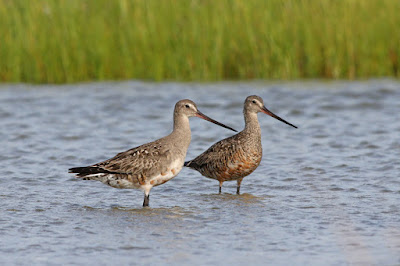Advanced travel planning in 2020 has been a bit of a lost cause for obvious reasons, so I have been eager to pounce on whatever reasonably safe opportunities have presented themselves for getting the %&$# out of Connecticut. This past weekend's hot, humid and dry weather inspired a long weekend on Cape Cod with friends. Shorebird migration should be in full swing, and seabird activity had been picking up at Race Point...hopes were high for a birdy weekend, and that's exactly what we got!
Dave Provencher and I departed CT very early on Friday (7/24) morning as we drove to Chatham with kayaks mounted on the car. We would attempt to kayak out to the South Beach/Monomoy complex in search of shorebirds and terns. We knew that this would pose a challenge, as the landscape out here has changed drastically since South Beach breached during a storm in 2013, making the waters extremely difficult to navigate. We paddled out of Morris Island on the low tide and were met with large exposed sand shoals as anticipated. This forced us to paddle pretty far west before we could turn south towards our destination. After navigating several shallow channels and making one brief portage, we passed between North and South Monomoy Islands and landed on South Beach for high tide. On South Beach we located one significant shorebird and tern roost and worked that for a while before beginning the paddle back to the mainland, which was more direct now that we had more water to work with. We tallied literally thousands of shorebirds of 18 species throughout the day, though we spent far more time paddling (some 11+ miles) than birding.
Given what we learned on Friday, we decided that on Saturday we should focus on the flats adjacent to Minimoy Island, a small island that is part of the NWR and itself is off-limits to the public. Joined by Sarah Dzielski from New York, the three of us set out again at low tide. We were able to be more efficient this morning since we could eliminate Friday's trial-and-error, so we made better time. This allowed for a few hours of wandering the mudflats east of the island, and there were loads of feeding shorebirds to look through. The highlight for us was the godwit flock - 13 HUDSONIAN and 1 MARBLED. But there was plenty more to see. I always enjoy a good WILLET [sub]species comparison, as will most other birders once they are split.
 |
| Hudsonian Godwits |
 |
Roseate Tern
|
 |
Common Tern
|
 |
Sanderlings plus
|
 |
Two "Western" Willets at right, the furthest right in alternate plumage. With "Eastern" Willet and Hudsonian Godwit.
|
 |
| Marbled Godwit |
After two days of extensive kayaking we were happy to spend Sunday on land, even though the heat and humidity really kicked up a notch. We were at Race Point by sunrise and enjoyed a wonderful shearwater show as 100+ each of GREAT, CORY'S, SOOTY and MANX were scoped with the sun over our shoulders. Three PARASITIC JAEGERS made passes throughout the morning. We did not connect with the subadult Sabine's Gull that has been seen intermittently over the past couple weeks, but the constant activity kept us on our toes. FIN and MINKE WHALES also made several appearances. The reliability of viewing seabirds at this location from a reasonable distance never ceases to amaze me.
 |
adult & juv Roseate Terns
|
 |
juv Roseate Tern
|
 |
juv Common Tern
|
 |
adult & juv Roseate Terns
|
 |
All four shearwater species could be seen in each mixed flock foraging offshore
|
 |
Gray Seals in the surf
|
The midday heat was a bit much to fight through today, so we retreated to A/C and resumed birding late in the afternoon. A stop to scan the water from Nauset Beach Light didn't produce anything of note. We then walked out Coast Guard Beach to its southern tip at the start of the falling tide. There were a few shorebirds around, though most seemed to be roosting across the channel on Nauset Beach. Separate flocks of GREAT BLACK-BACKED and LAUGHING GULLS were on our side of the cut, and amongst the Laughers was an alternate-plumaged adult FRANKLIN'S GULL. We watched this bird for several minutes as it preened vigorously and eventually flew off to the south, as did most of the flock as the tide dropped and the sun began to set.
 |
Franklin's Gull among Laughing Gull flock
|
 |
| wing stretch |
It was back to the 'yaks on Monday, launching from Chatham and making the short paddle across the inlet to North Beach Island in search of roosting shorebirds, which were in very short supply. Back to focusing on gulls, we picked out a first-summer LESSER BLACK-BACKED GULL amongst the large gull flock on the outer beach.
As the tide dropped we paddled over to Tern Island and birded the expanding mudflats, which held several hundred shorebirds. We had a good study of SHORT-BILLED DOWITCHERS including at least one of the Prairie 'hendersoni' race and a few that seemed intermediate with 'griseus.' Another "WESTERN" WILLET was there, and Dave picked out a distant PECTORAL SANDPIPER that made only a brief appearance. In all, fifteen shorebird species on the flats here.
 |
| I tend to be pretty conservative when it comes to identifying hendersoni Short-billed Dows in New England. Some are really obvious and have solid orange down through the vent, with sparse spotting at the breast sides, and broad golden 'tiger stripes' above. Birds like the one pictured in the foreground above I think are very likely hendersoni. When this bird was turned away and bent over feeding, you could see orange between the legs and through the vent, though the rear flanks lack orange. The upperparts of this bird are not broadly barred with gold, but it is brighter than the griseus feeding behind it. |
This marked the end of our long weekend on the Cape that was loaded with thousands of shorebirds, seabirds, and a surprise Franklin's Gull. Cape Cod is a coastal birder's paradise, especially at this time of year when shorebird migration really gets cranking. Those of us who reside in southern New England are lucky to have it within a reasonably short driving distance.
- Nick




















Comments
Post a Comment